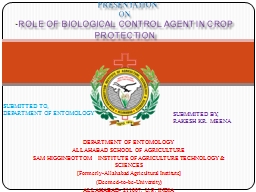

ALLAHABAD SCHOOL OF AGRICULTURE SAM HIGGINBOTTOM INSTITUTE OF AGRICULTURE TECHNOLOGY amp SCIENCES FormerlyAllahabad Agricultural Institute DeemedtobeUniversity ALLAHABAD 211007 UP INDIA ID: 1021780
Download Presentation The PPT/PDF document "DEPARTMENT OF ENTOMOLOGY" is the property of its rightful owner. Permission is granted to download and print the materials on this web site for personal, non-commercial use only, and to display it on your personal computer provided you do not modify the materials and that you retain all copyright notices contained in the materials. By downloading content from our website, you accept the terms of this agreement.
1. DEPARTMENT OF ENTOMOLOGYALLAHABAD SCHOOL OF AGRICULTURESAM HIGGINBOTTOM INSTITUTE OF AGRICULTURE TECHNOLOGY & SCIENCES[Formerly-Allahabad Agricultural Institute](Deemed-to-be-University)ALLAHABAD- 211007, U.P., INDIA PRESENTATION ON “Role of biological control agent in crop protection SUBMMITED BY,RAKESH KR. MEENASUBMITTED TO,DEPARTMENT OF ENTOMOLOGY
2. TOPICRole of biological control agent in crop protection
3. Biological control is a method of suppressing or controlling the population of undesirable insects, other animals or plants by the introduction, encouragement, or artificial increase of their natural enemies. (Weeden et al. 2007). Characteristics: Climatic adaptabilitySynchrony with host (prey) life cycle
4. 3. High reproductive potential4. Efficient search ability5. Short handling time6. Survival at low host (prey) densityThere are three main techniques of biological control:- Classical Augmentative Conservation.
5. Classical-Importing foreign natural enemies to combat theintroduced pests.Example:Vidalia beetle applied against cottony cushion scale.
6. Augmentation:-It is a tactics of biological control where, the effort ismade to increase the natural enemy population eitherby propagation and release or by environmentalmanipulation.Inundative - Parasitoids Cotesia are applied against sugar cane borer. 2. Inoculative - Parasitic wasp Encarsia formosa are applied against glasshouse whitefly
7. Conservation:- Conservation is defined the actions to preserve an increase the natural enemies by environmental manipulation.Agents of biological control 1. Macro agent-InvertebratesVertibratesInsectBirdsArachnidsMammals
8. 2. Micro agent :- Bacteria VirusesFungiNematode5. Protozoa
9. Tricogramma chilonis on corcyra cephalonica Rodolia Eating Icerya
10. Some important insects and their natural enemiesInsect pest Natural enemies Pod borer Parasitoids: Trichogramma chilonis (egg), Tetrastichus spp. (egg), Campoletis chlorideae (larval), Bracon spp. (larval) etc. Predators: Chrysoperla carnea, coccinellids, praying mantis, pentatomid bug (Cantheconidae furcellata).
11. Braconid parasitoid wasp eggs & Lime ButterflyPredatory Polistes wasp looking for bollworms or other caterpillars on a cotton plant
12. Insect pestNatural EnemiesAphids and White flyParasitoids: Aphidius colemani, Aphelinus spp. etc. Predators: green lacewings Chrysoperla carnea, predatory coccinellids (Stethorus punctillum), spiders, wasps etc. Tobacco caterpillar Parasitoids: Trichogramma chilonis (egg), Chelonus blackburni (egg-larval, Campoletis chlorideae (larval)Predators: Chrysoperla carnea, coccinellids.
13. Lady beetle feeding on aphid This parasitic wasp lays eggs inside the bodies of aphids
14. Insect pestNatural enemiesLeafhoppers Predators: Lady beetle, ants Distina albino, Chrysoperla spp., mirid bug (Dicyphus hesperus).Spider mites and yellow mites Predators: Anthocorid bug(Orius spp.) green lacewing(Mallada basalis) Fungal pathogen: Beauveria bassiana (entomo pathogen)
15. Vertebrates:Birds (class Aves) -- Some birds, such as swifts, warblers, vireos, and flycatchers are almost exclusively insect predators. Moles, bats (class Mammalia) - Soil-dwelling mammals are predators on white grubs and the pupal stages of many flies and moths. Bats (order Chiroptera) feed exclusively on small, flying insects. The little brown bat (Myotis lucifugus) may forage up to 30 miles away from home and eat more than half its weight in insects every night.
16. Micro agentFungus:- Natural populations of insects are commonly attacked by fungal pathogens, fungi are slow to kill their hosts. The fungal mycelium usually invades all body tissues and may eventually cause suffocation by blocking the tracheal system.FungusHost insectVerticillium lecaniiAphid. White fliesMetarhizium anisopliaeLeaf hopper, beetle
17. Beauveria bassiana on host
18. 2. Bacteria Members of the genus Bacillus are especially important as biological control agents. Some of these bacteria cause turbidity of body fluids (e.g., Bacillus papillae). Other species form toxic protein crystals in conjunction with spore formation (e.g., Bacillus thuringiensis). Each strain has slightly different host specificity:
19. PathogenBrand NameHost RangeBacillus thuringiensisvar. kurstakiBiobit, Javelin, Thuricide, DipelLepidopteran larvaeBacillus thuringiensisvar. israelensisTeknar, Bactimos, VectobacDipteran larvaeBacillus thuringiensisvar. tenebrionisTrident II, M-TrakColeopteran larvaeBacillus papillaeDoom, Japidemic, Milky Spore DiseaseScarab beetle larvae
20. 3. Virus The use of entomopathic viruses for insect control is still in its infancy. Many of these pathogens appear to have good potential as biocontrol agents because they are relatively host-specific. NPV or CPV:- They usually attack larvae of Lepidoptera or Hymenoptera (sawflies). 2. Granulosis virus :- They usually attack codling moth (Cydia pomonella).
21. 4. NematodeThere are over 300 species of nematodes (in 19 families) that are known to attack insects. Most of the research in biological control, however, has focused on only two genera, Steinernema and Heterorhabditis. Examples:-Steinernema feltiae or Heterorhabditis heliothidis applied against soil dwelling larvae.
22. Entomopathogenic nematodes emerging from a root weevil larva they killed.
23. 5. ProtozoaMost species of entomopathic protozoa cause chronic infections that weaken, but do not kill their host. For this reason, there is little interest in these organisms as biocontrol agents. One notable exception is Nosema locustae, a microsporidian that has been mass-produced and marketed for control of grasshoppers under the trade name "Hopper Stopper.
24.